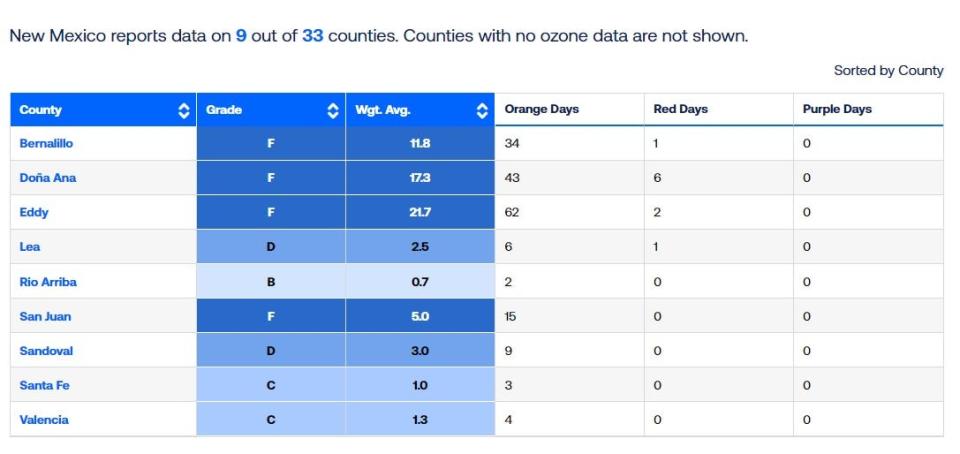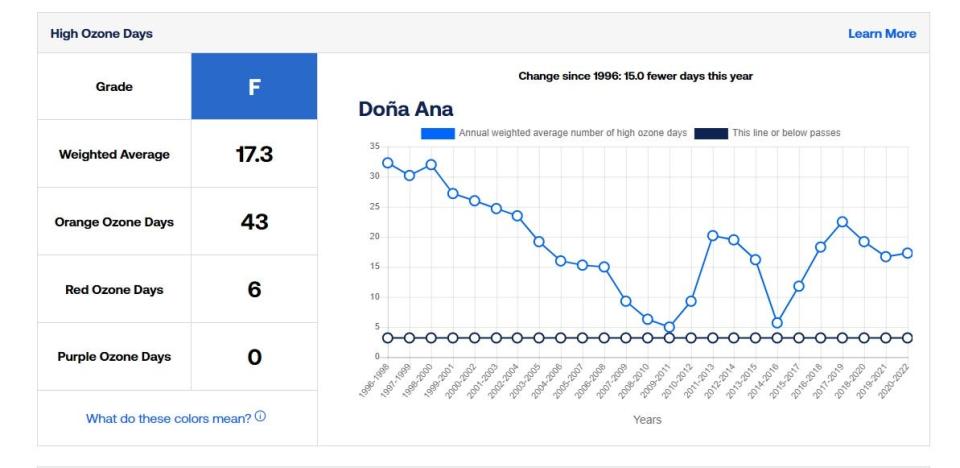National study reports air pollution throughout New Mexico. How does your community rank?
New Mexico's biggest urban center and an oilfield county ranked among the top air-polluted areas in the U.S., according to a national study.
The American Lung Association on April 24 released its annual “State of the Air” report identifying communities throughout the U.S. suffering from air pollution via ozone, or smog, and particulate matter pollution.
Several of the state’s counties showed elevated levels of both pollutants, the study read.
Here’s how New Mexico fared in air pollution, compared with the rest of the U.S.
Less than a third of New Mexico counties measure for air pollution
Of New Mexico’s 33 counties, only 10 reported data for the State of the Air report. That’s because Bernalillo, Doña Ana, Eddy, Lea, Rio Arriba, Sandoval, San Juan, Santa Fe, Taos and Valencia counties were the only ones where ozone and particulate matter pollution is calculated.

Northern New Mexico urban areas rank among most polluted cities
The study combined the Albuquerque-Santa Fe-Las Vegas metro area, ranking the area as the 21st most-polluted city by ozone in the U.S. Bernalillo County received an F grade for both high ozone and high particle pollution between 2020 and 2022, the report read. The report showed 35 days of high ozone levels in Bernalillo County, and 16 days of high particle concentration.
Santa Fe County got a C grade with three high-ozone and one high particle pollution days.
Other urban areas rank high for air pollution
North of Bernalillo sits Sandoval County and New Mexico’s third-most populated city in Rio Rancho. Sandoval earned a D grade from the American Lung Association, with nine high ozone days.
To the southwest, Doña Ana County which contains Las Cruces also received and F grade with 49 high ozone days and 11 days of high particle pollution, the study read.

Oilfield communities struggle with worsening air quality
Aside from New Mexico’s major cities and suburbs, rural counties in the oil patch showed air pollution rivaling that of the more-populated regions of the state. Eddy County appeared worse off in southeast New Mexico, according to the study, ranked as the 17th in the nation among counties for ozone pollution.
Eddy County received an F from the American Lung Association, reporting 64 high-ozone days between 2020 and 2022, more than both Albuquerque and Las Cruces. Neighboring Lea County was given a D grade with seven high-ozone days and one high particle pollution day during the same time frame. Eddy County’s high particle days were not included in the study as there is no monitoring there for such pollution.
#CleanFuelStandards not only decrease emissions and move us toward our climate goals, but also diversify our economy and attract new businesses. With my signature today, NM became the 4th state in the U.S. to adopt these standards. pic.twitter.com/haziE5ObtA
— Governor Michelle Lujan Grisham (@GovMLG) March 6, 2024
In the northwest San Juan Basin, San Juan County also received and F with 15 high-ozone days, but did not measure for particle pollution, read the study.
Why is New Mexico at a higher risk of air pollution than other states?
JoAnna Stother, the New Mexico director of advocacy for the American Lung Association, said the state’s air quality appeared to be worsening while the group’s recent research showed improvements around the U.S.
She pointed to increased climate change impacts like wildfires along with hotter, dryer temperatures impacting air quality throughout the state. Expanded oil and gas operations in southern New Mexico, Strother said, could put more chemicals known as precursors to ozone into the air, where they interact with higher temperatures and levels of sunlight to produce ozone or smog.
“Southern New Mexico is definitely seeing an increase in ozone,” Strother said. “While the rest of the country is improving. We know we have oil and gas over there. We know that fossil fuels make air quality worse and makes health outcomes worse.”
Burning fossil fuels in combustion engines for cars and trucks was likely behind worsening air pollution in Albuquerque and urban areas, Strother said, as the transportation sector was believed the second-highest cause of greenhouse gas emissions after fossil fuel production. She said the state should transition away from fossil fuels to mitigate these effects.
State, feds look to improve air quality
New Mexico recently enacted a mandate at the New Mexico Environment Department that auto manufacturers average at least 42 percent of fleets offered for sale to New Mexico dealers be electric by 2026 and 82 percent by 2032, to aide in pollution reduction.
When communities ask - we do our best to respond. Read our letter of intent to the @EPA seeking grant funding for a new #air quality monitoring station in Southeastern #NewMexico. #CleanAir https://t.co/wp1lgrtsI9 pic.twitter.com/gawoB9dHN0
— New Mexico Environment Department (@NMEnvDep) January 20, 2022
Meanwhile, the Environmental Protection Agency on April 15 opted to retain its existing standards for multiple air pollutants after a review, to the chagrin of environmentalists. These included nitrogen oxides and particulate matter. The agency did propose revisions to its sulfur dioxide (SO2) rules, requiring the annual average be within 10 to 15 parts per billion in a given area.
“The EPA failed to seize this important opportunity to better protect plants and animals from these toxic pollutants,” said Ryan Maher, a staff attorney at the Center for Biological Diversity. “Air pollution standards must protect endangered plants and wildlife, but the agency failed to follow the law, or the science, to fully address this toxic air pollution’s harms to the environment.
Adrian Hedden can be reached at 575-628-5516, achedden@currentargus.com or @AdrianHedden on the social media platform X.
This article originally appeared on Carlsbad Current-Argus: New Mexico counties rank poorly for air quality in national study

